Topic clusters are a group of web pages that focus on different aspects of the same topic. They allow you to cover a topic in depth by using each page in the cluster to focus on a particular sub-topic of the main topic.
They help your readers to better understand a topic. But topic clusters are also a valuable SEO tool because they help to build your website’s authority for particular topics.
In this article, you’ll discover:
- what topic clusters are
- why they help with SEO
- how to create them
Let’s dive in!
What Are Topic Clusters?
A topic cluster is a series of interlinked articles or blog posts clustered around a particular topic.
Content clusters are a bit like ‘category’ pages in WordPress. A category page contains links to all the pages or articles that cover that same category.
The difference between the two is that a category page is simply a list of sub-pages, whereas the central page in a topic cluster is usually a lengthy article that gives a broad overview of a particular topic.
Here’s an example:
Let’s say I have a website that deals with outdoor sports.
And on that website, I have a web page that covers rock climbing.
My rock climbing page links to a series of related pages, each of which deals with one of the following topics:
- Crampons
- Ice picks
- Harnesses
- Carabiners
- Ropes & Cords
- Rappel devices
The rock climbing page and the pages it links to are a content cluster.
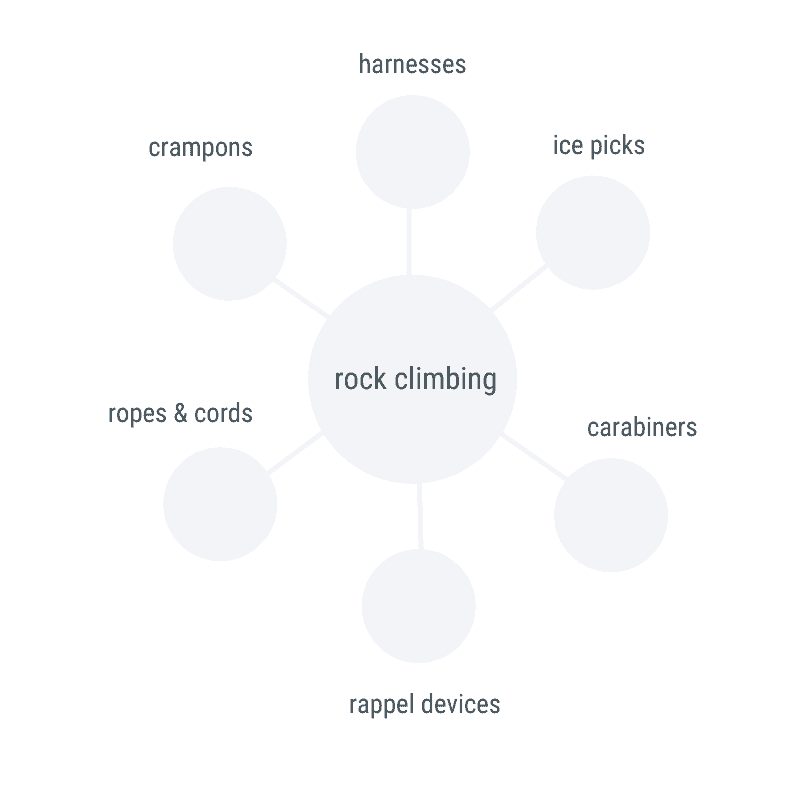
You can think of a topic cluster as a central page surrounded by satellite pages.
A key aspect of content clusters is internal linking.
Ideally, every satellite page should contain links to every other page in the content cluster.
FURTHER READING
- Topic Clusters: The Next Evolution of SEO
- What Are Topic Clusters? (& Why Do I Need Them Anyway?)
- What Are Topic Clusters (And How Can They Boost Your Traffic)?
Topic Clusters and Pillar Posts
The page at the center of a content cluster is often referred to as a ‘pillar post’.
Pillar posts
It’s called a pillar post because it’s usually one of 5 to 10 key content pages that define the focus of a website.
Pillar pages are often long-form content. They typically give a broad overview of a topic.
In my example above, the rock-climbing page is a pillar post.
Pillar posts often have titles such as:
- The Complete Guide to SEO
- Email Marketing – the Definitive Guide
- Guest Posting – Everything You Need to Know
Satellite pages
The satellite pages surrounding a pillar post go into particular sub-topics in more detail.
For example, the satellite pages for a pillar post about ’email marketing’ might be:
- How to Segment Email Lists for More Opens and Click-Throughs
- 22 Simple Ways to Grow Your Email List
- 13 Best Email Marketing Services
- 7 Email Marketing Metrics You Need to Follow
- How to Create Email Marketing Funnels
Pillar posts and satellite pages
The pillar post on email marketing plus these 5 sub-topic posts would together form a topic cluster.
A key characteristic of a pillar page is that it broadly covers a given topic. In that sense, it acts as a gateway to the pages that cluster around it.
Those satellite pages deal with sub-topics of the main topic. And they cover those sub-topics in much more detail than was possible in the pillar post.
If you’re like me, and many other bloggers, you may not have many pillar pages.
The reason?
We’ve been so busy chasing long tail keywords that we rarely, if ever, write broadly-focused articles.
After all, an article about ’email marketing’ is going to be much harder to rank on Page #1 of the search results than an article about ‘email marketing funnels’.
But when a pillar page has a series of sub-topic pages linking to it, it has a much better chance of ranking on Page #1.
Why?
Because it’s at the center of a topic cluster and that means it has topical authority.
What is Topical Authority?
In 2013 Google introduced the Hummingbird algorithm and semantic analysis.
This algorithm allows the search engine to recognize that certain keywords cluster together in predictable patterns.
And that’s where topic clusters come in.
It’s difficult for a single piece of content to cover a topic definitively.
But what about a series of articles, each of which covers a different aspect of that topic?
That’s going to have topical authority.
And topical authority is now a ranking factor.
So the pillar post at the center of that topic cluster is going to rank well in the SERPs.
Topic Clusters vs Keyword Optimization
Topic clusters are beginning to replace keywords.
Ten years ago, people used to focus on individual keywords.
But with Hummingbird and RankBrain the focus now is context, not isolated keywords.
Increasingly, search engines are trying to understand searcher intent, and that means the algorithms are trying to understand context and meaning.
Gone is the era when you could optimize a page for a single keyword.
Topic Clusters and SEO
When you create an interlinked cluster of pages around a pillar page, you signal to the search engines that this is a cluster of semantically-related pages.
And that’s the kind of content that search engines are now favoring: semantically-related content, also known as topic-based content.
Search engines are favoring sites that cover a particular topic with authority.
Why?
Because the search engines realize that visitors to a website that has topical authority are likely to find all the answers they need in one place, instead of having to visit multiple websites.
The result?
The website with well-organized topic clusters is going to rank better in the search results.
But there’s another reason why content clusters perform well in the search results.
Because the pages in a content cluster are interlinked, when one page gets an SEO boost it transfers link juice to the other pages in the topic cluster.
Five Tips for Creating Topic Clusters
Here are five key tips that will help you create your topic clusters
#1. Understand the subtopics
The first step to creating an SEO-friendly topic cluster is to understand how your main topic breaks down into subtopics.
One the best ways of doing this is to look at the table of contents in online articles.
Here’s a table of contents (ToC) from an article on ‘backpacking in Europe’:
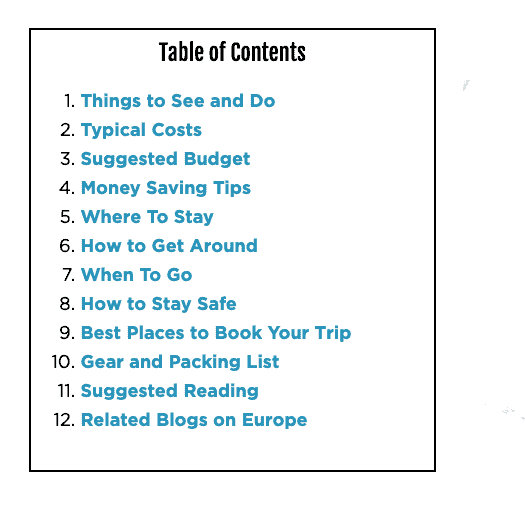
Each heading in the ToC is a subtopic that could be a separate article in your topic cluster.
Here’s another ToC, this time from an article on ’email marketing’:
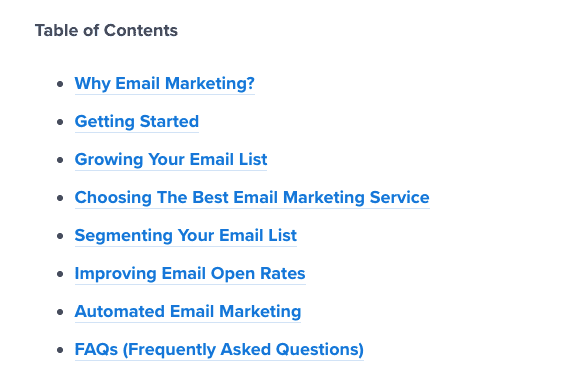
Again, the headings in this ToC could each be the topic of a separate blog post in your topic cluster.
Here’s another one, from an article on ‘portrait photography’:
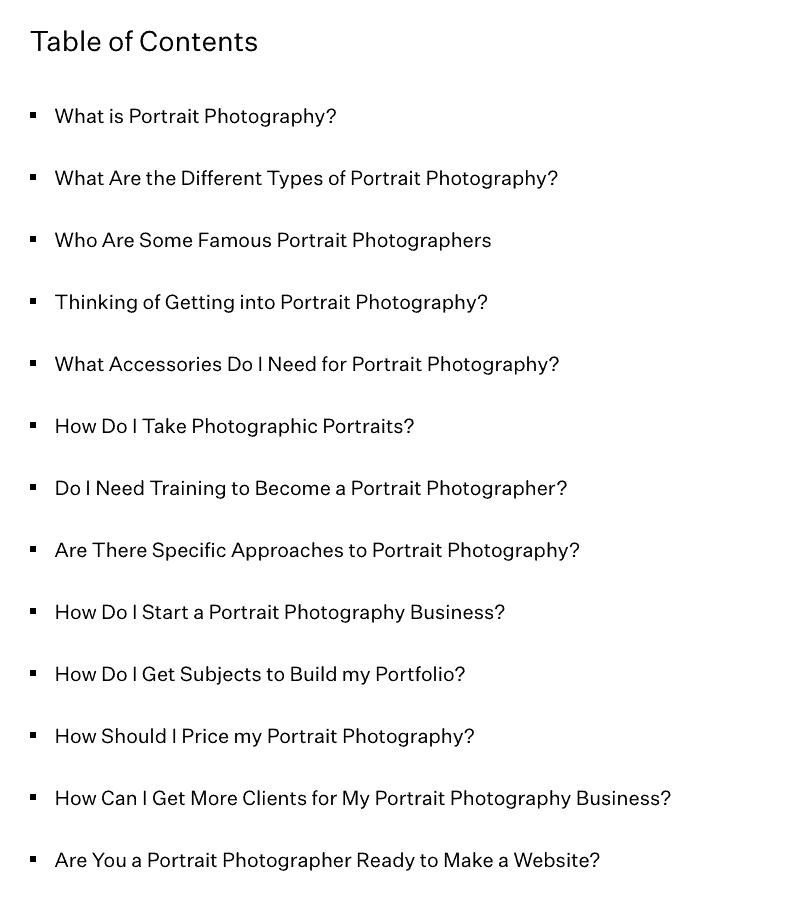
These headings would all make great topics for separate articles within your topic cluster.
#2. Use Google Auto Suggest to find subtopics
Here’s another way to find subtopics within your main topic. Type your main keyword into Google and look for long tail keyword variations.
Let’s take the keyword: ‘internal linking best practices’:
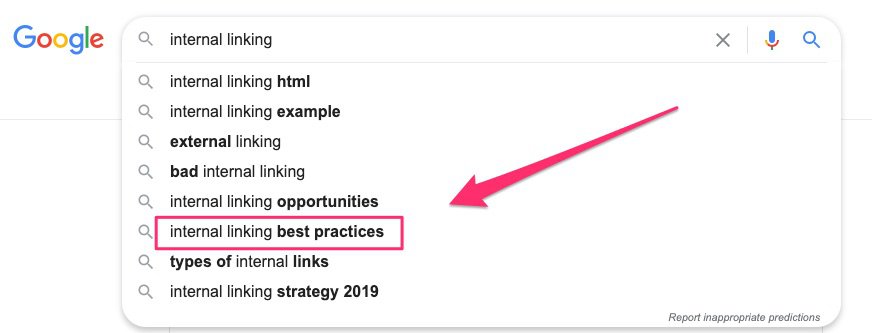
Write an article around that keyword and link that article to your main article on ‘internal linking’.
Next, type your keyword into Google Search, followed by the letter ‘a’ and look for another longtail keyword variation. Let’s take the keyword ‘internal linking anchor text’:
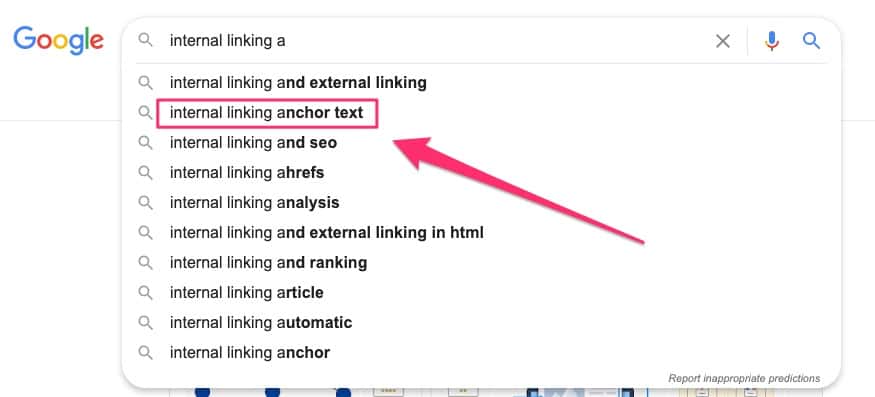
Next, type your keyword into Google followed by the letter ‘b’ and look for another longtail variation. Let’s take the keyword: ‘internal linking benefits’:
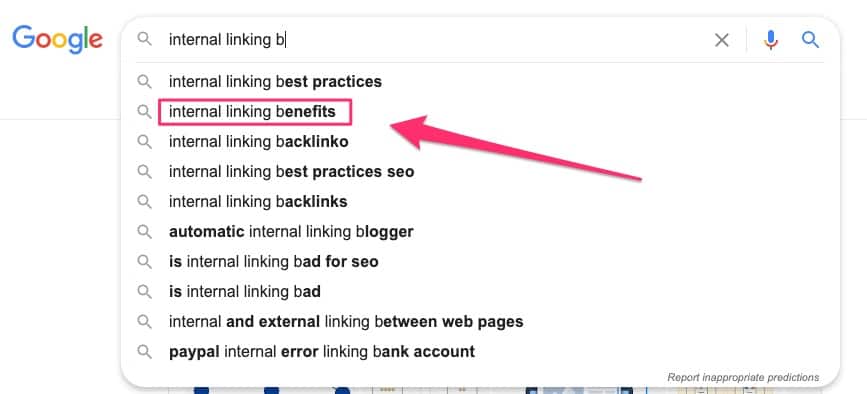
Repeat the exercise using the letters ‘c’, ‘d’, and ‘e’:
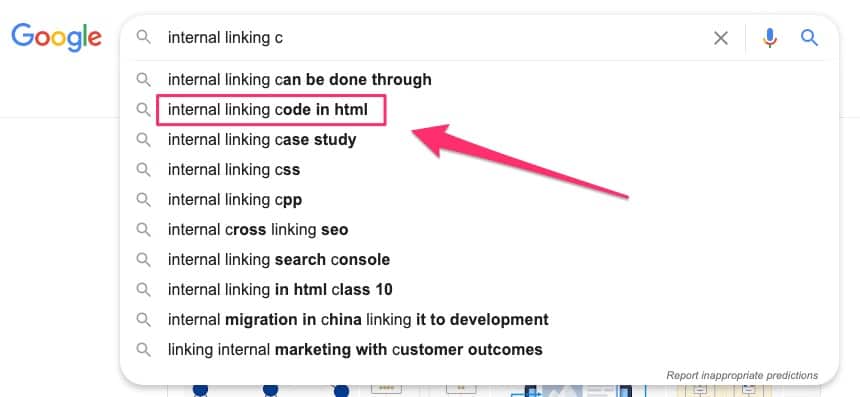
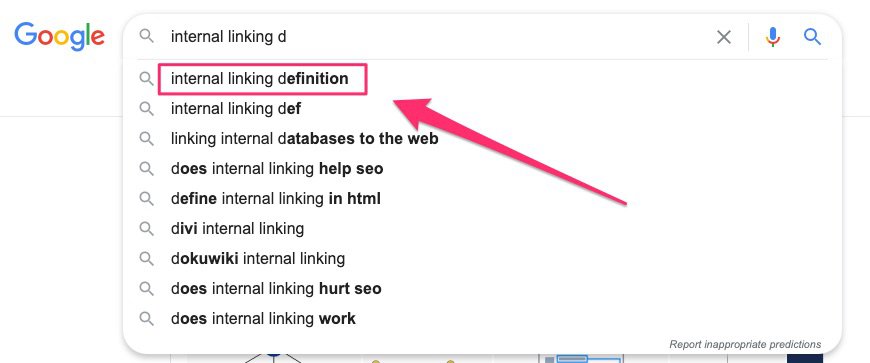
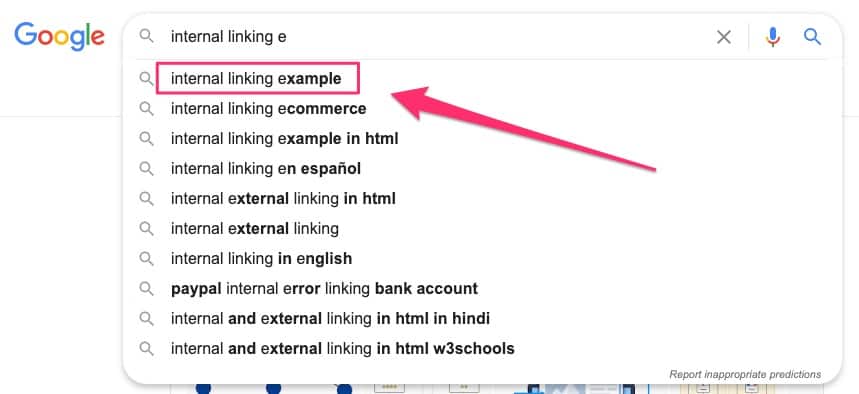
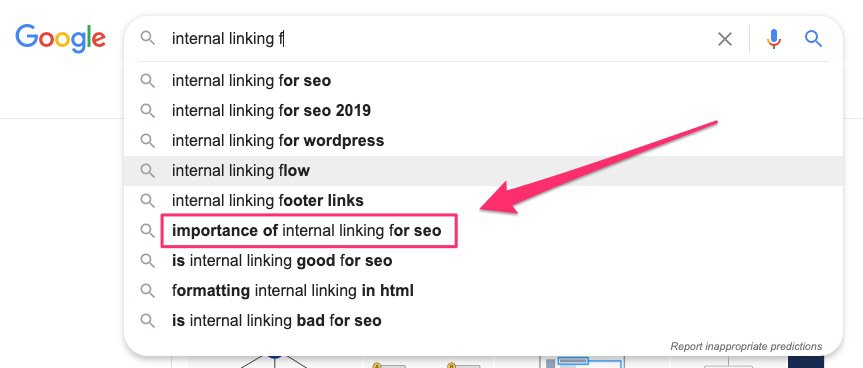
So to recap, you now have six additional articles that deal with long tail variations of your main keyword:
- internal linking best practices
- internal linking anchor text
- internal linking benefits
- Internal linking definition
- Internal linking example
- Importance of internal linking for seo
Once you’ve written those six articles, you then link them back to your main article. You also link your main article to the six ‘satellite’ articles:
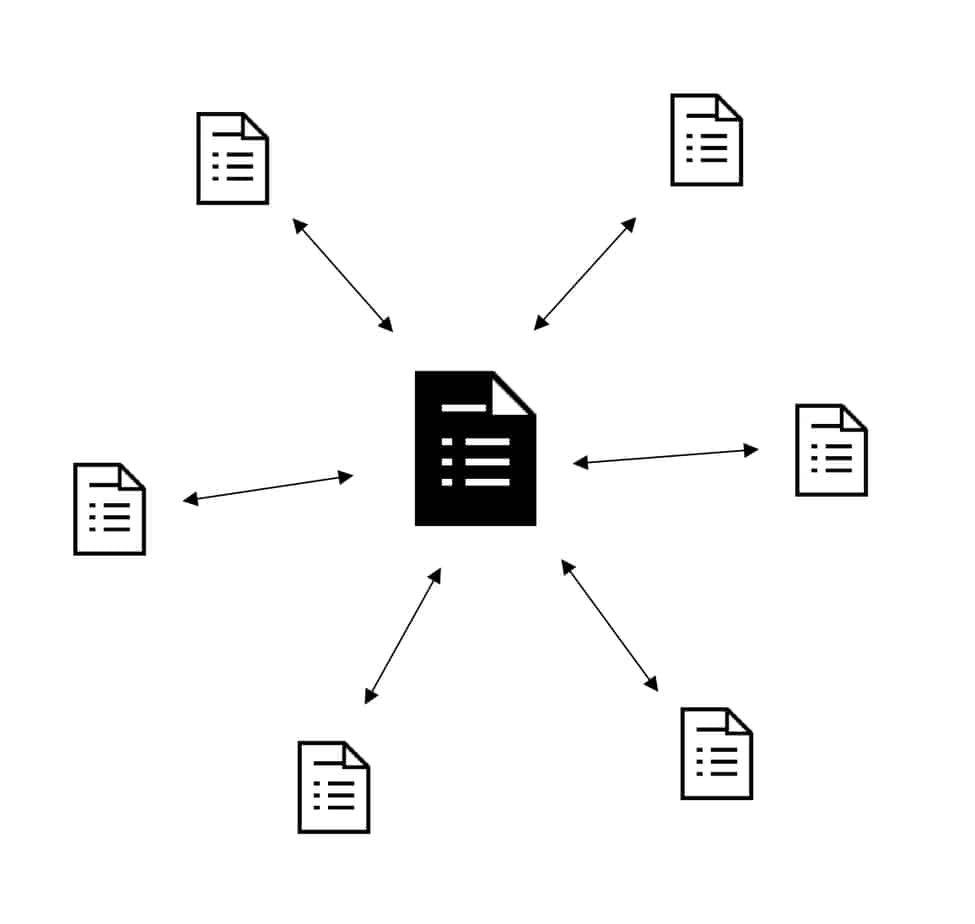
#3. Create content clusters from existing content
To create content clusters from your existing articles and blog posts you first need to do a content audit.
Specifically, you need a spreadsheet of your articles so that you can examine the titles and see which of your articles would naturally fit into a topic cluster.
You can do this with a simple plugin called Export Post Info.
After installing and activating this plugin, enter a name for your download file, click ‘save Changes’, and then click on the download link:
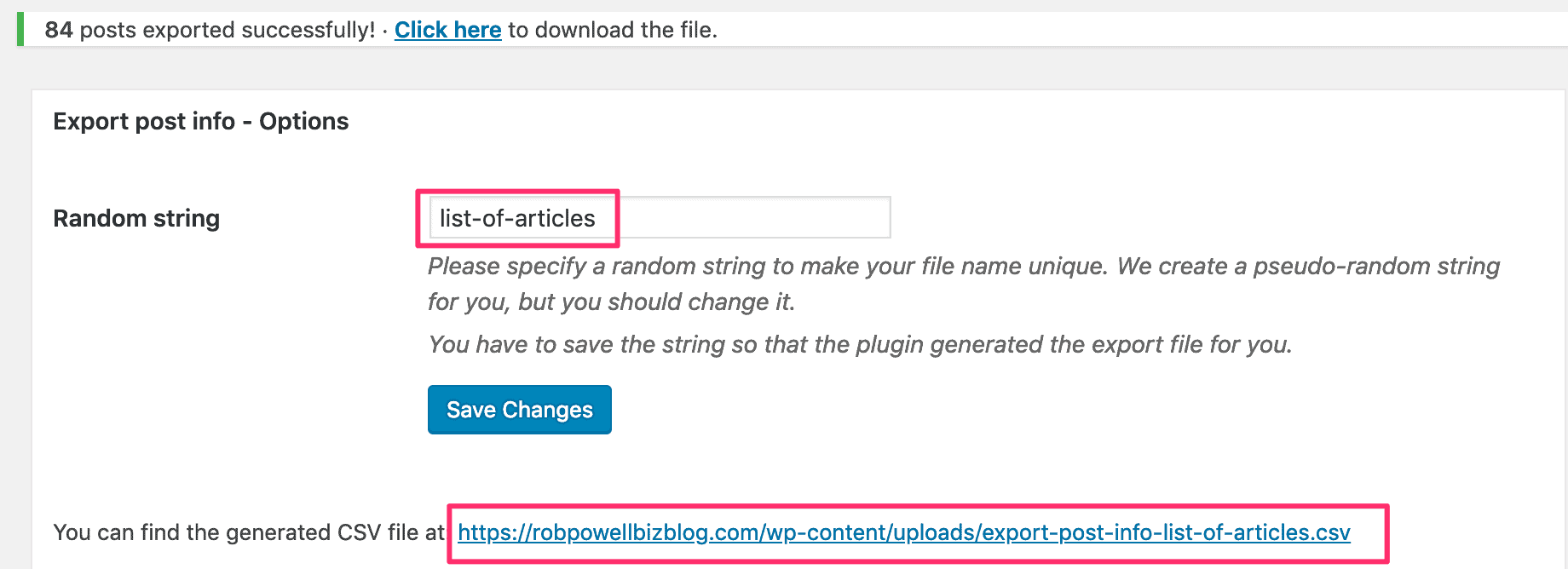
The plugin creates a CSV file with the following columns:
- Date
- Title
- Number of words
- URL
- Category
Open the CSV file in Microsoft Excel and create a new column titled ‘Topic Clusters’.
In the new column you just created, make a note of the broad topic of the article. Then sort the spreadsheet by the column titled Topic Clusters.
You’ll find small groups of articles that share the same broad topic. These are your topic clusters:
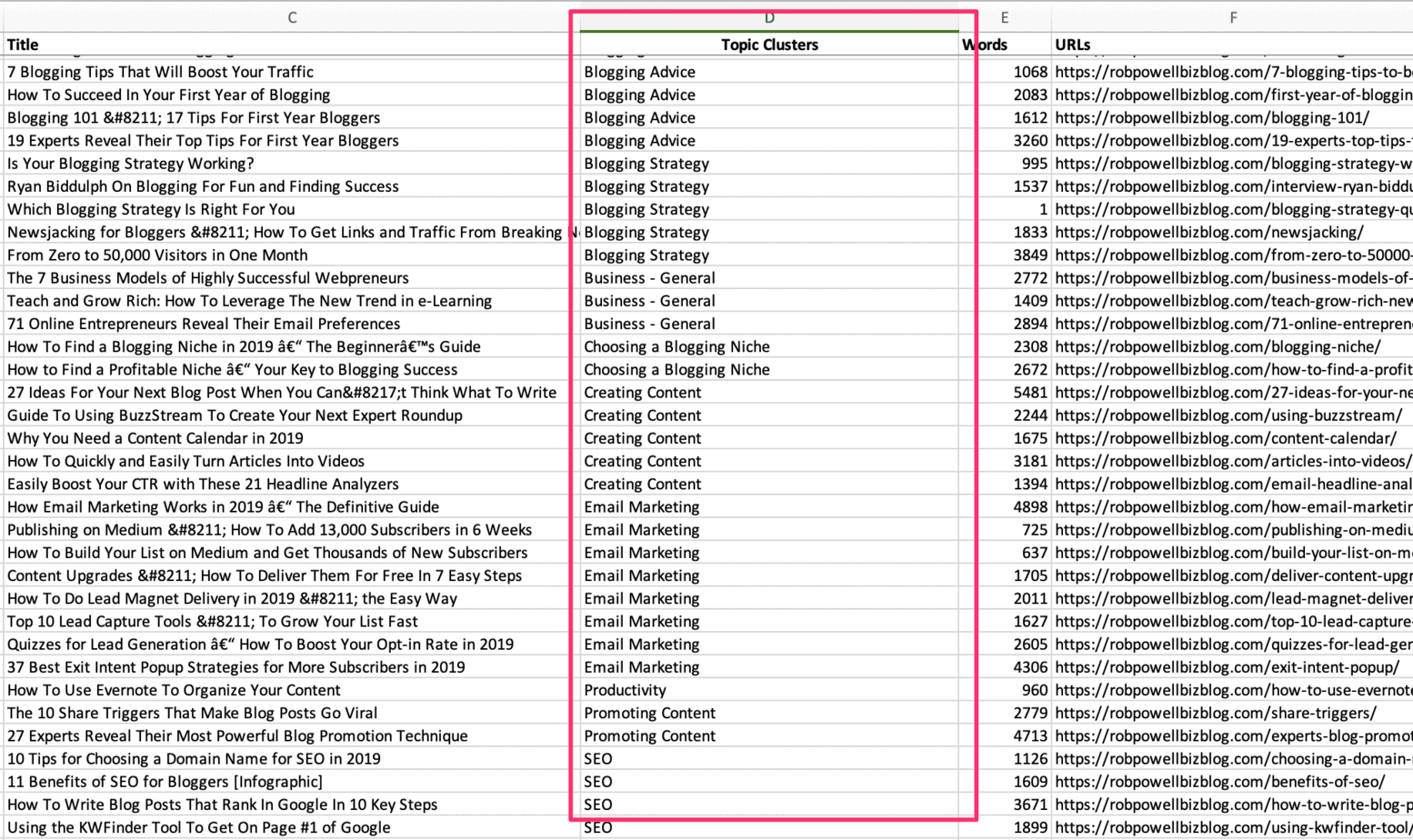
In each topic cluster there may be an article that will serve as the pillar post for that topic cluster.
If not, you can easily create one using the process I outlined in the previous section.
When creating topic clusters from your existing content, remember to remove all the previous internal links that lead to other pages on your website.
You want the search engine bots to clearly recognize that this is a self-contained topic cluster.
And that means that the internal linking should be restricted to the cluster itself.
#4. Create a topic cluster with a table of contents
There are various ways of doing internal links in a topic cluster.
Here are some examples.
Topic Cluster Example #1 – The Anatomy of a SaaS Marketing Site
This topic cluster uses a Table of Contents at the top of each of the cluster pages:
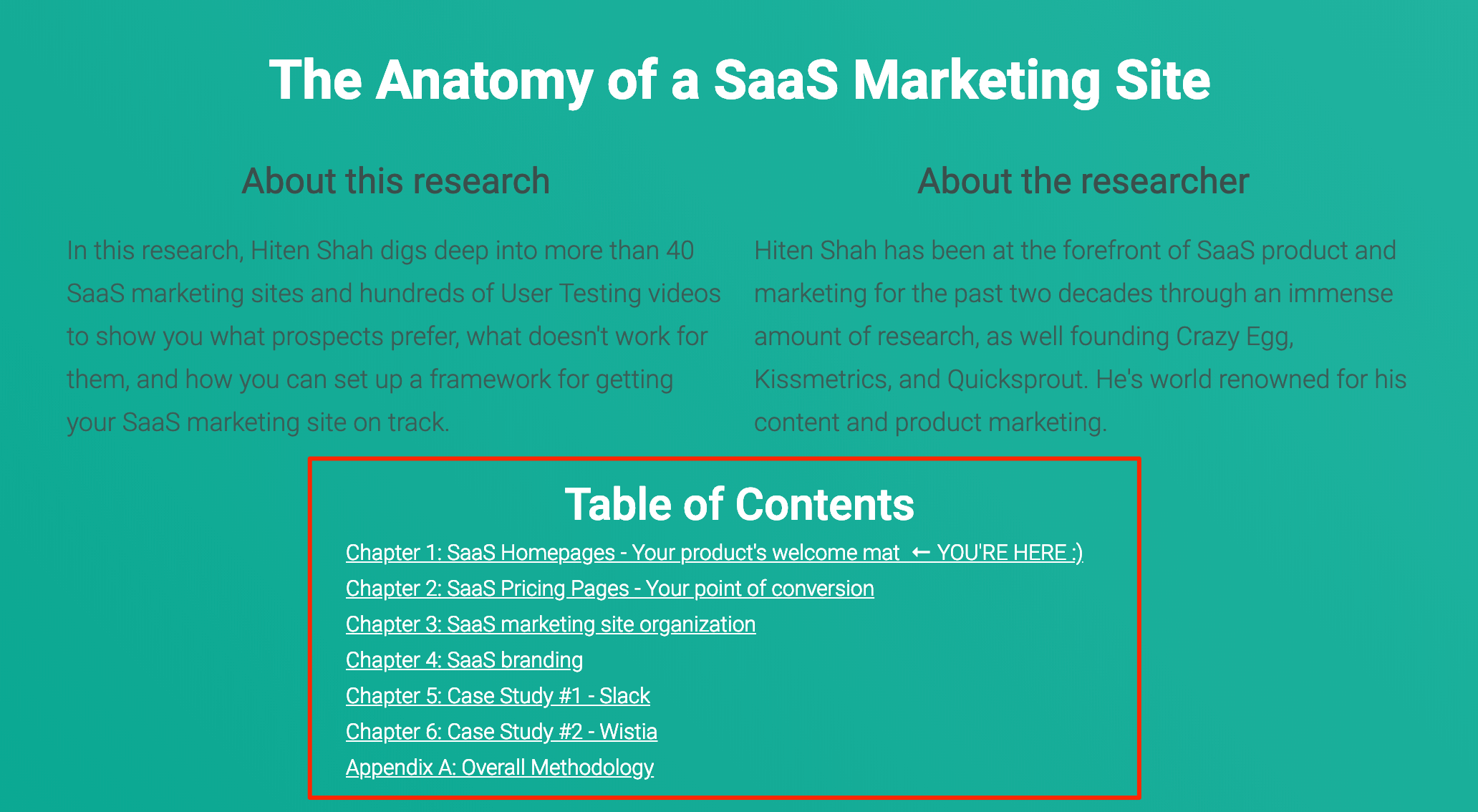
At the foot of each page, it provides a link to the previous page and a link to the next page.
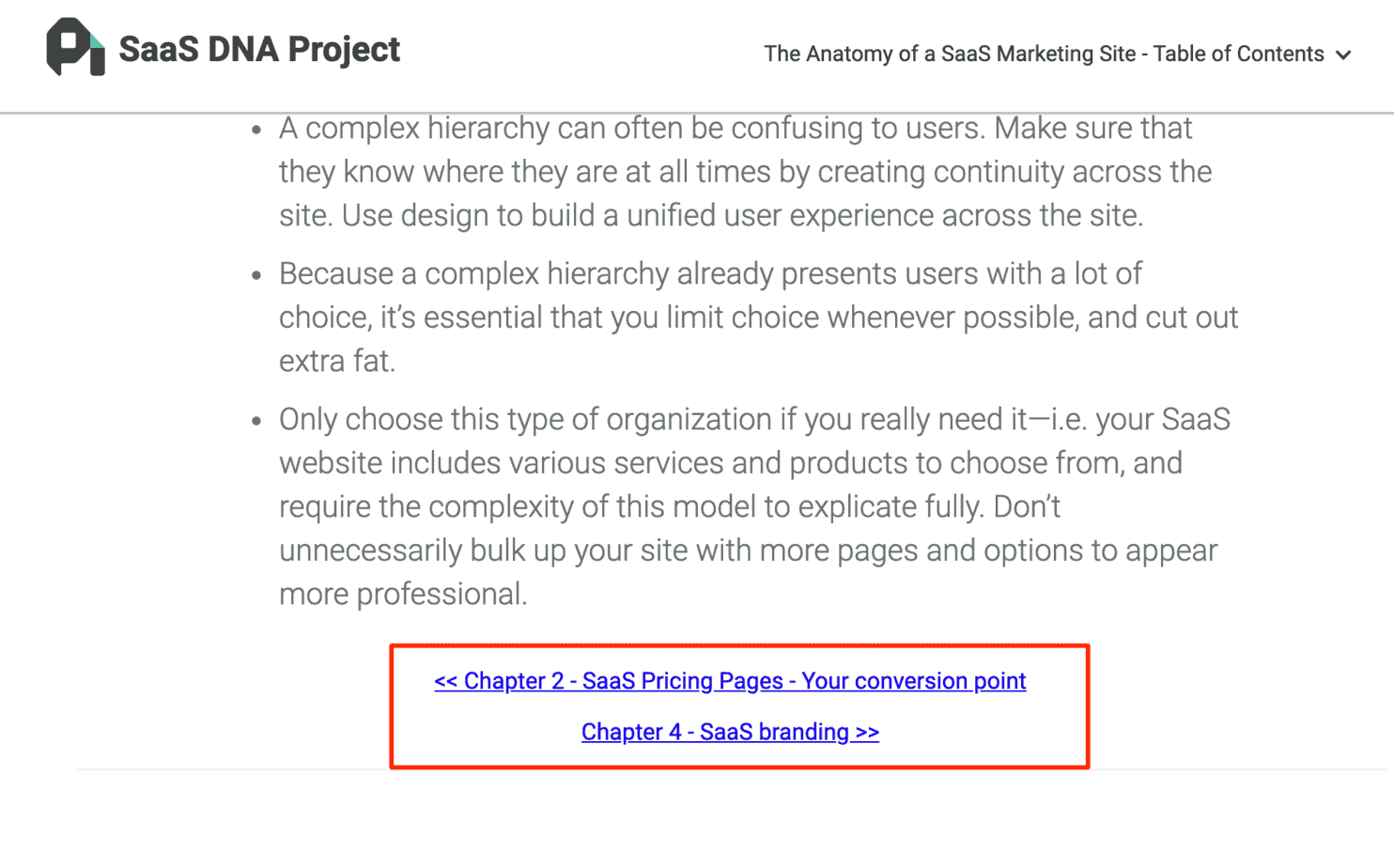
This is a great linking strategy:
- a Table of Contents navigation ensures that every cluster page links to every other page
- the top navigation gives the reader an overview of what the topic cluster consists of
- the bottom navigation encourages the reader to follow a sequence of pages
Topic Cluster Example #2 – Moz Guide to Content Marketing Strategy
This topic cluster uses the same two kinds of navigation as the previous example: ‘Table of Contents’ navigation as well as ‘Previous and Next’ navigation:
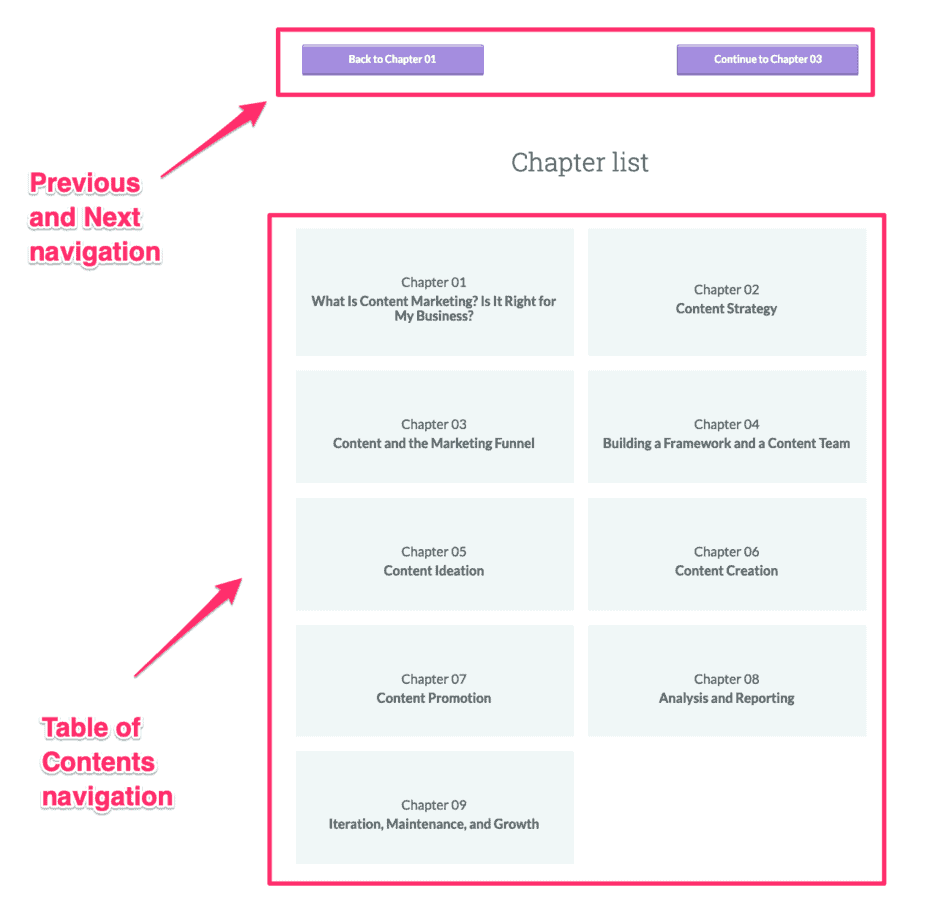
Topic Cluster Example #3 – Moz Beginners Guide to SEO
This topic cluster, also from Moz, uses these same two internal linking techniques:
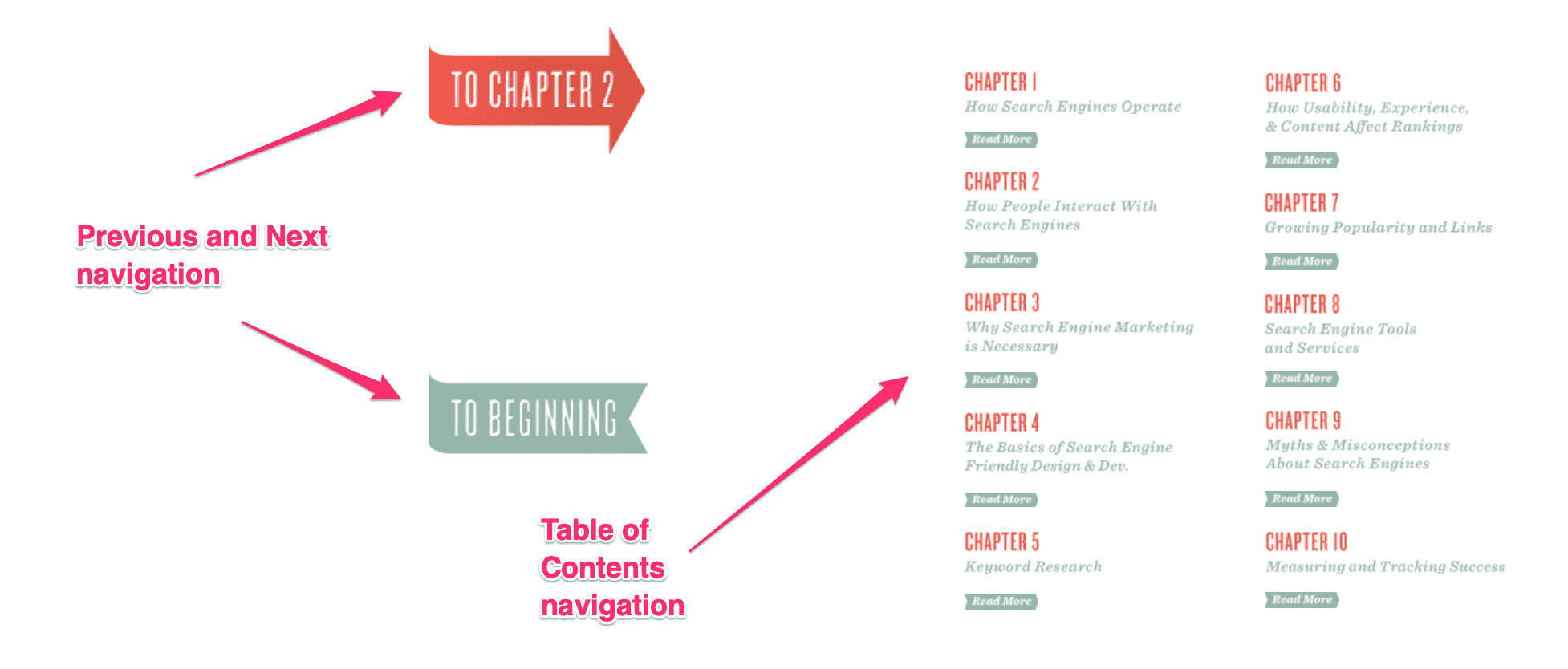
From an SEO point of view the vital linking strategy in all three examples is the ‘Table of Contents’ linking:
- It tells the search engines that this is a topic cluster
- If one page in the topic cluster gets a ranking boost, the benefit will be passed on to the other pages in the cluster
#5. Create topic clusters with ‘Related Article’ blocks
A great way to create topic clusters is to place a ‘related Articles’ block at the foot of your blog posts.
But the key to making this work is to find articles on your website that are closely related to the main article.
And what better way to do that than ask Google itself?
Think about it…
Google has already indexed your online content. So Google should be able to tell you which of your published articles are most relevant to the main article.Here’s how to do it:
Take the primary keyword for your article and type it into Google, using this search string:
site:yourdomain +keyword
Google will now list the blog posts on your website that share the most topical relevance for that keyword.In the example below, I refer to the article that contains the ‘Related Articles’ block the “host article”.
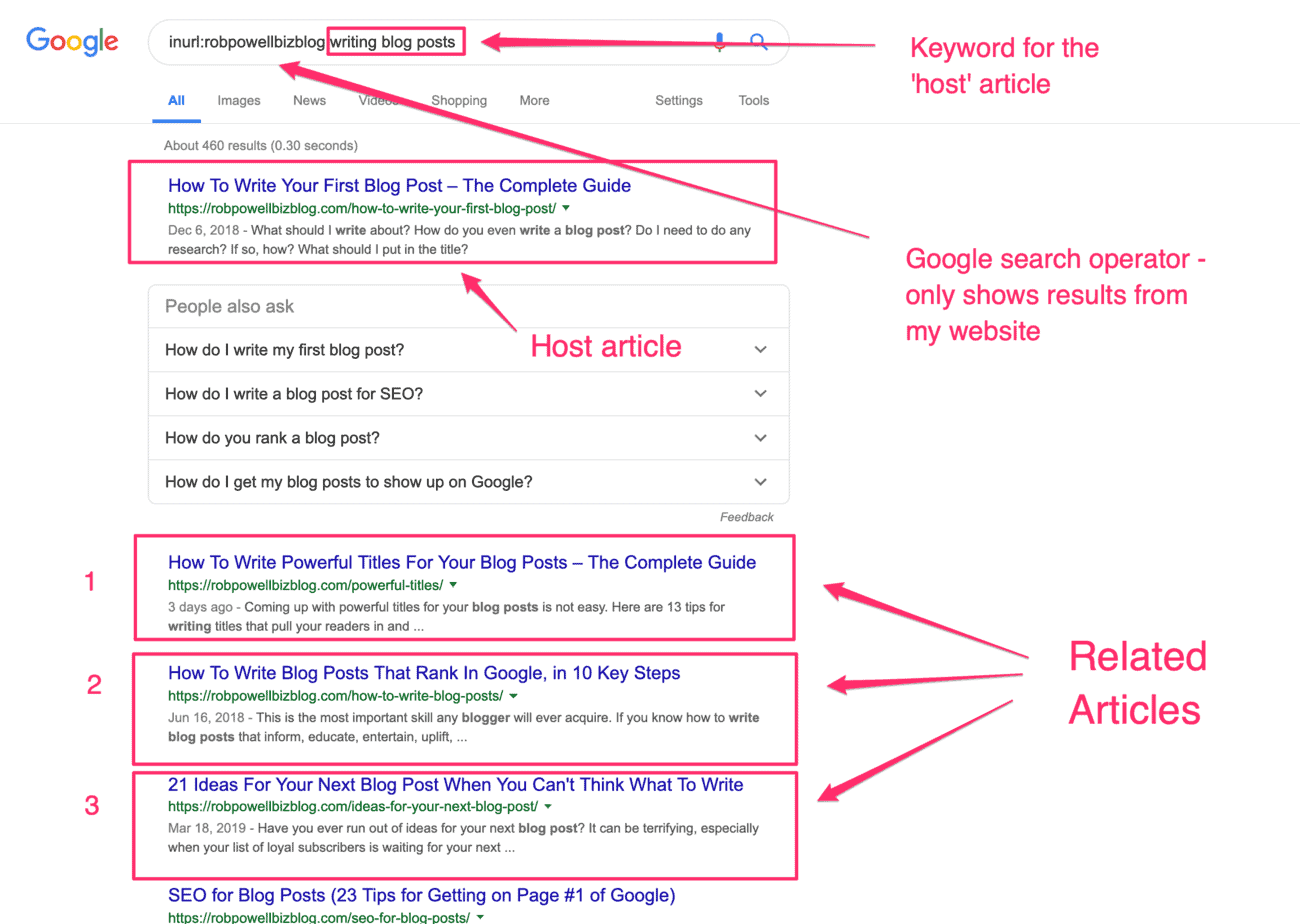
Then create a box at the foot of your article and title it ‘Related Articles’. Copy and paste the titles of your related articles. Insert links to those article and you have a topic cluster (like the one at the foot of this article).
Conclusion
Organizing your content into topic clusters will help rank your articles higher in the search results. This is because search engines are now focussing on context and topical authority, rather than single keywords.
In this article I’ve shown you how to create new content clusters from scratch and also how to organize your existing content into content clusters.
A vital aspect of content clusters is internal linking.
Each page in the cluster should be linked to every other page in the cluster, preferably using a ‘Table of Contents’ linking strategy, as outlined above.
If you’re looking for a single SEO strategy that will lift your rankings in the search engines – this is the one!
Hello Rob! Wow, I loved the content! Very informative and practical. Congratulations!
Hi Helio, thanks for the feedback. I’m glad it was useful 🙂 Best, Rob.
Well done Rob. I see you all over Google. Awesome.
Hey Ryan! Thanks for stopping by – good to see you here. I hope things are going well in your neck of the woods.
All the best, my friend 🙂
Rob
Hey Rob.!
Thanks for sharing these awesome tips. Just one question though, if I change the URL of one of my related articles, will the plugin update it automatically or do I need to do it manually?
Hi Samm,
Good question. The process I use for adding related articles is manual, so if you ever wanted to change the URL for one of the links in your ‘Related Articles Block’, you would need to do that manually.
Hope this answers your question.
Best, Rob.
Great content as always -and extremely helpful. I wasn’t aware of the content clusters but I’ll keep an eye from now on.
Thanks, once again, for writing such an in depth article, Rob.
Thanks, George. I love your website, by the way (and your ‘About’ page). I can relate to what you say. All the best, Rob.
Hi Rob,
Great content as always -and extremely helpful.
I have a question for you.
How to create a box at the foot of your article and title it ‘Related Articles’ like your posts?
Thanks,
Hi Trung, thanks for your question. I created the ‘Related Articles’ box in Thrive Architect, which is a plugin from the people at Thrive Themes. I’ve made a short video showing how I made the ‘Related Articles’ box: https://vimeo.com/347890803
Hi Rob,
Thank you so much for your video.
It is extremely helpful.
Thanks and Best Regards,
Trung
You’re welcome 🙂
Hey Rob great post. I googled topic clusters and found this post. Thank you for teaching me about topic clusters. This post has given my content real direction. Thank you for writing it simply but informatively.
You’re welcome, Poovanesh! Thanks for your feedback.
Best – Rob
Hi Rob,
I have one more question.
Do you know any other free ‘Related Articles’ plugins that have similar features?
Can you recommend that plugin?
Thanks,
Hi Trung,
Thanks for your question.
Here’s a list of all the ‘related post’ plugins that I know of. Most of them are free or have free versions:
– Jetpack Related Posts
– Bibblio
– Yet Another Related Posts Plugin (YARPP)
– Related Posts for WordPress
– Contextual Related Posts
– Related Posts by AddThis
– Similar Posts by Shareaholic
– Better Related Posts Widget
– Related Posts Pro
– Related Posts by Maria Shaldybina
– Related Posts by Taxonomy
– Inline Related Posts
– Related Post By PickPlugins
The problem with ‘related post’ plugins is that they put a heavy load on your server response time and so they slow down your website. Page speed is now a major ranking factor and that’s why I don’t use a ‘related posts’ plugin (I just manually create a block at the foot of each post containing related posts).
However, there is one related posts plugin that apparently doesn’t slow down your site: Bibbilo. The makers of this plugin say: “The heavy-lifting is handled on our side, and our modules load after your page does, so nothing slows down”. But if using Bibblio (or any other Related Posts plugin) I would test your page speed (using Pingdom Tools) before and after, so you know for sure what impact its having on your page speed.
I hope this answers your question.
Regards,
Rob.
Hey Rob,
As usual a great article.
If you don’t mind, I’d like to ask you a question. I am organizing my content into silos following your suggestions. Therefore i have a category page (which is my silo page) and under this page a list of posts that all link to each other and to the silo page.
Now, can i create a topic cluster around a single page under the main silo page? For instance, let’s say my silo page is Tennis Rackets and the supporting pages are Slazenger, Wilson, Head. Can I create a topic cluster around Slazenger? Would that break the silo structure?
Thx
Hi Luca,
Thanks for your question.
If you have at least 5 articles on Slazenger rackets, then, by all means, you can create a new cluster around Slazenger (those articles would link to “Slazenger” and not to “tennis rackets”). The rule here is that once you have at least five articles or blog posts on a sub-topic (Slazenger) you can turn the sub-topic into its own cluster. You would then start earning authority for “Slazenger” and that authority for Slazenger is going to feed into your overall authority for “tennis rackets”.
I hope this helps.
Rob.
Thanks Rob once again for a great piece of content.
On our website, we publish product reviews. As a test, we tried to follow tips in this article to optimize 2 reviews that were doing fine but we needed to boost them even more.
We improved internal linking toward the review and we attempted to create topical authority. Therefore, for each product, we added 5/6 cluster articles on topics related to the main product.
Immediately after the test started, both product reviews have lost ranking as many keywords started to lose positions. It is 3 weeks now that the negative trend continues.
It looks like the creation of cluster content has generated a keyword dilution issue.
Any idea on what could have caused the issue and why the topical authority content didn’t work in our case?
What went wrong?
Thx a lot for your comments.
Hi Matt,
It sounds like you may have inadvertently diluted the strength of your existing content. Also, with topic clusters, make sure you have at least 5 ‘satellite’ pages for every ‘hub’ page. Less than that and you weak topical authority for the hub page.
Best, Rob
Hey Rob, Great article. Would you suggest making the pillar pages static pages and the satellites could be posts? Thanks
Hi Matt,
Thanks for your question.
Yes, that would certainly work. However, pages are usually reserved for content relating to the site itself (e.g. ‘about’ page, ‘contact’ page, ‘services’ page, etc.) In other words, pages are best for content that doesn’t change. My preference is to use posts for content that is about the actual topics you cover on your website.
I hope this answers your question,
Regards, Rob.